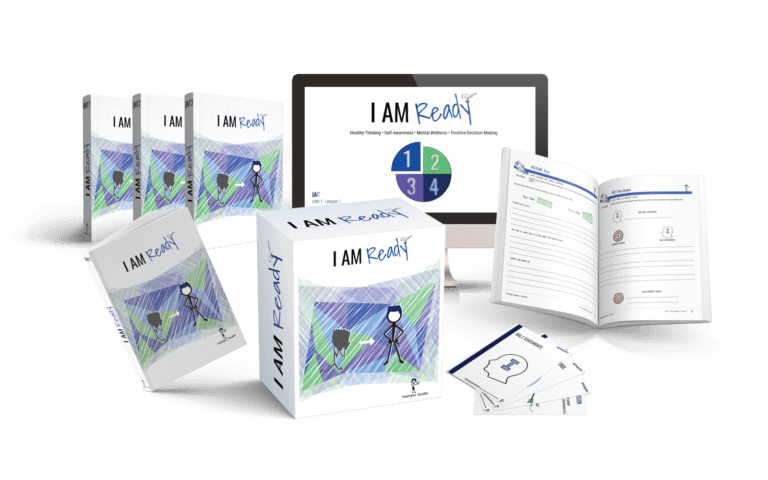Teach · Coach · Mentor

I AM READY
Curriculum
I AM READY

Unit 5: What are You Thinking?
Guiding Questions:
What is self-control?
What is the relationship and interconnectedness between thoughts, feelings, and behaviors?
How can I control internal and external events?
Unit Description:
Everyone is susceptible to Thinking Errors. In Unit 5, learners explore ten common Thinking Errors and the destructive impact that such cognitive distortions can have on one’s internal events.
Learners take a cognitive distortion survey to determine which Thinking Errors they are most prone to commit. Learners roleplay common Thinking Error scenarios and explore how Thinking Errors magnify a negative internal voice (‘little i’).
Learners then complete a Thinking Plan. The Thinking Plan helps one identify common Thinking Errors. The Thinking Plan also helps students engage the START Tool. The START Tool helps students stop negative thinking patterns and reframe negative thoughts into positive and empowering Big I Statements. Finally, learners explore the cyclic and damaging relationship between Thinking Errors and distorted Rules for Living.
Lesson Overviews
Lesson One
Overview
Learners are introduced to ten common Thinking Errors and take an inventory to evaluate which errors they are susceptible to. Learners review and create TRY Goals and discuss highs and lows with their Accountability Partners.
Critical Activities
- Take A Stand
- Picture This
- Dig DEEP
- Climb Our Mountain
- WHIP Around
Objectives
- Define Thinking Errors
- Connect Thinking Errors and Rules for Living
- Evaluate high, lows, challenges, and successes in recent experiences
Learning Targets
- Rules for Living are automatic assumptions about how the world operates.
- A Daily RFL is a mental shortcut we use to make decisions in everyday routine experiences and events.
- A Protective RFL is a mental shortcut that helps us make decisions in a potentially threatening or unusual situation.
- An RFL that is distorted and applied to inappropriate situations is called Distortion.
- A distorted belief creates distorted thoughts, feelings, and actions.
Lesson Two
Learners explore self-control challenges and establish their WHY for course participation. This Happened! and Tracking My Day Tools reflective tools are introduceOverview
Learners explore common Thinking Errors and the negative ‘little i’ statements associated with each Thinking Error. The Thinking Plan and Start Tool are introduced.
Critical Activities
- Words I Wish I Wrote
- Tie it Together
- Picture This
- This Happened! Event Journal
- Tracking My Day
Objectives
- Understand how Rules for Living are developed
- Connect Rules for Living to internal events
- Identify thoughts, behaviors, and actions of others through roleplay
- Challenge cognitive distortions with Six Seconds to Ready
Learning Targets
- My RFLs influence my experiences. My experiences reinforce my RFLS.
- The RFL Cycle creates a powerful mental habit that impacts all aspects of my daily life.
- Distorted RFLs create distorted and irrational thoughts.
Lesson Three
Overview
Learners explore stress management through Today & Tomorrow Episode 5, complete the Empathy Map, and practice a guided meditation.
Critical Activities
- Tie it Together
- Tune in! Today & Tomorrow
- Picture This
- Back-to-Back
- A Picture Speaks a Thousand Words
Objectives
- Identify thoughts, behaviors, and actions of others through story
- Identify I AM Ready tools for specific situations and scenarios
- Practice applying tools to characters in story
Learning Targets
- Targets and Statements are reviewed in the Transformation Circles and Accountability Partners.
Lesson Four
Overview
Learners explore the relationship between Thinking Errors and distorted Rules for Living. Learners practice applying the START tool for three self-identified statements that are negatively contributing to the Thinking Error and Rules for Living Cycle.
Critical Activities
- Whip Around
- Tie it Together
- Take a Stand
- Picture This
- A Picture Speaks a Thousand Words
Objectives
- Review inner voice
- Identify thoughts, behaviors, and actions of others through story
- Practice challenging cognitive distortions with Six Seconds to Ready
- Build positive internal scripts
Learning Targets
Targets and Statements are reviewed in the Transformation Circles and Accountability Partners.
CBT Terms and Tools
Terms:
- Rules for Living
- Daily Rules for Living
- Protective Rules for Living
- Distortion
- Distress
- Trauma
- Chronic Stress
IAR Tools:
- This Happened! event journal
- Tracking My Day record
- Learning Targets
- Big I Statements
- ‘Above the Bar’ behaviors
- ‘Below the Bar’ behaviors
- Climb Our Mountain journal
- RFL Cycle Walk
- Six Seconds to Ready
